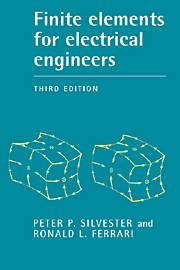Book contents
- Frontmatter
- Contents
- Preface to the third edition
- Preface to the first edition
- 1 Finite elements in one dimension
- 2 First-order triangular elements for potential problems
- 3 Electromagnetics of finite elements
- 4 Simplex elements for the scalar Helmholtz equation
- 5 Differential operators in ferromagnetic materials
- 6 Finite elements for integral operators
- 7 Curvilinear, vectorial and unbounded elements
- 8 Time and frequency domain problems in bounded systems
- 9 Unbounded radiation and scattering
- 10 Numerical solution of finite element equations
- Appendix 1 Calculations on simplex elements
- Appendix 2 Integration by parts, Green's theorems and Green's functions
- Appendix 3 Simplex element tables
- Appendix 4 Utility programs and style notes
- Appendix 5 Laboratory problems and exercises
- Index
8 - Time and frequency domain problems in bounded systems
Published online by Cambridge University Press: 05 June 2012
- Frontmatter
- Contents
- Preface to the third edition
- Preface to the first edition
- 1 Finite elements in one dimension
- 2 First-order triangular elements for potential problems
- 3 Electromagnetics of finite elements
- 4 Simplex elements for the scalar Helmholtz equation
- 5 Differential operators in ferromagnetic materials
- 6 Finite elements for integral operators
- 7 Curvilinear, vectorial and unbounded elements
- 8 Time and frequency domain problems in bounded systems
- 9 Unbounded radiation and scattering
- 10 Numerical solution of finite element equations
- Appendix 1 Calculations on simplex elements
- Appendix 2 Integration by parts, Green's theorems and Green's functions
- Appendix 3 Simplex element tables
- Appendix 4 Utility programs and style notes
- Appendix 5 Laboratory problems and exercises
- Index
Summary
Introduction
It is possible to take time variation into account in electromagnetics finite element analysis at a number of different levels of complexity. If the rates of time variation are sufficiently slow, the pre-Maxwell versions of the fundamental electromagnetic laws neglecting the displacement-current term ∂D/∂t in the Maxwell magnetic curl equation, may be assumed. This is allowable at power frequencies and may also apply at higher frequencies when considering miniature components; however microwave and optical configurations will ordinarily require displacement current to be included in any analysis. Another simplification arises if all of the materials concerned are linear, in which case analysis in the frequency domain is possible. Subsequently a transformation back to the time domain using standard inversion methods may be made, whilst in many cases the frequency domain solution is meaningful in itself. In this chapter attention is focussed upon two areas, eddy current modelling and the analysis of bounded high-frequency systems such as waveguides and cavities, for both of which very useful differential operator finite element computations can be accomplished.
Eddy currents
When a time-varying magnetic field is set up within a conducting body, the resulting Faraday emf acting around closed paths enclosing the field causes circulating eddy currents to flow within the body. Many electrical machines and power devices depend heavily upon the effects of time-changing magnetic fields, so eddy currents are generated within them and give rise to unwanted power dissipation.
Information
- Type
- Chapter
- Information
- Finite Elements for Electrical Engineers , pp. 344 - 403Publisher: Cambridge University PressPrint publication year: 1996
